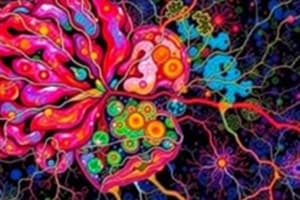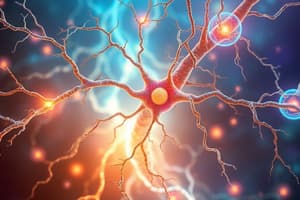Podcast
Questions and Answers
Nerves are the dynamic 'functional units' of the nervous system.
Nerves are the dynamic 'functional units' of the nervous system.
False (B)
Substance P is found in the pain impulse pathway from the spinal cord to the brain.
Substance P is found in the pain impulse pathway from the spinal cord to the brain.
True (A)
Some hormones can act as neurotransmitters and some neurotransmitters can act as hormones.
Some hormones can act as neurotransmitters and some neurotransmitters can act as hormones.
True (A)
Neurons outnumber neuroglia cells 50:1.
Neurons outnumber neuroglia cells 50:1.
Receptor cells detect stimuli and afferent neurons conduct the stimulus to the CNS.
Receptor cells detect stimuli and afferent neurons conduct the stimulus to the CNS.
Another name for an interneuron is an association neuron.
Another name for an interneuron is an association neuron.
Responses are carried out by muscles or glands known as effectors.
Responses are carried out by muscles or glands known as effectors.
Neurons leading from the PNS to the CNS are called efferent neurons.
Neurons leading from the PNS to the CNS are called efferent neurons.
The integrative function of the nervous system is carried out by the CNS.
The integrative function of the nervous system is carried out by the CNS.
Neurons exhibit an 'all-or-none' response for action potentials.
Neurons exhibit an 'all-or-none' response for action potentials.
Nerves exhibit 'graded responses', but usually not all-or-none responses.
Nerves exhibit 'graded responses', but usually not all-or-none responses.
Which very specific structure of the neuron contains the vesicles of neurotransmitter?
Which very specific structure of the neuron contains the vesicles of neurotransmitter?
Which structure of the neuron receives a stimulus from another neuron?
Which structure of the neuron receives a stimulus from another neuron?
Which structure of the neuron transfers an impulse away from the soma?
Which structure of the neuron transfers an impulse away from the soma?
The two anatomical divisions of the nervous system are the ____ and ____.
The two anatomical divisions of the nervous system are the ____ and ____.
The two physiological divisions of the nervous system are the ____ and ____.
The two physiological divisions of the nervous system are the ____ and ____.
The division of the nervous system that consists of the brain and the spinal cord is the ___.
The division of the nervous system that consists of the brain and the spinal cord is the ___.
The conduction rate of myelinated neurons is ____ times faster than non-myelinated neurons.
The conduction rate of myelinated neurons is ____ times faster than non-myelinated neurons.
Which of the following have several dendrites and one axon?
Which of the following have several dendrites and one axon?
Which of the following produce the myelin sheath on neurons in the CNS?
Which of the following produce the myelin sheath on neurons in the CNS?
Which of the following produce the myelin sheath on neurons in the PNS?
Which of the following produce the myelin sheath on neurons in the PNS?
Which of the following form and move cerebral spinal fluid in the brain?
Which of the following form and move cerebral spinal fluid in the brain?
Which of the following is NOT true about astrocytes?
Which of the following is NOT true about astrocytes?
Which of these is NOT a property of nerve cells?
Which of these is NOT a property of nerve cells?
Which of the following has the greatest influence on RMP?
Which of the following has the greatest influence on RMP?
The most abundant glial cells in the CNS are:
The most abundant glial cells in the CNS are:
There exists 40X the concentration of _____ inside the neuron as there is outside of the neuron:
There exists 40X the concentration of _____ inside the neuron as there is outside of the neuron:
There exists 12X the concentration of _____ outside the neuron as there is inside of the neuron:
There exists 12X the concentration of _____ outside the neuron as there is inside of the neuron:
The subdivision of the PNS that carries efferent signals to the skeletal muscles to produce muscular contractions under voluntary control is the:
The subdivision of the PNS that carries efferent signals to the skeletal muscles to produce muscular contractions under voluntary control is the:
The subdivision of the PNS that carries efferent signals to the glands, cardiac and smooth muscles to produce effects under involuntary control is the:
The subdivision of the PNS that carries efferent signals to the glands, cardiac and smooth muscles to produce effects under involuntary control is the:
The subdivision of the PNS that carries afferent signals from the heart, lungs, and stomach to the CNS is the:
The subdivision of the PNS that carries afferent signals from the heart, lungs, and stomach to the CNS is the:
The subdivision of the PNS that carries afferent signals from the skin, muscles, bones, and joints to the CNS is the:
The subdivision of the PNS that carries afferent signals from the skin, muscles, bones, and joints to the CNS is the:
Which of the following is NOT true for a local potential?
Which of the following is NOT true for a local potential?
Which of the following is NOT true for an action potential?
Which of the following is NOT true for an action potential?
For a neuron to fire, the internal voltage must reach a specific voltage, which is called:
For a neuron to fire, the internal voltage must reach a specific voltage, which is called:
The trigger zone is also called the...
The trigger zone is also called the...
-55mV is...
-55mV is...
Which of these is associated with relative refractory period?
Which of these is associated with relative refractory period?
-70mV is...
-70mV is...
Which of these is maintained by the sodium-potassium pump?
Which of these is maintained by the sodium-potassium pump?
When the internal membrane voltage of a neuron becomes more negative, after it peaks in the positive direction, it is referred to as...
When the internal membrane voltage of a neuron becomes more negative, after it peaks in the positive direction, it is referred to as...
When the internal membrane voltage of a neuron becomes more positive.
When the internal membrane voltage of a neuron becomes more positive.
Flashcards
Functional unit of nervous system
Functional unit of nervous system
Neurons, not nerves, are the basic units of the nervous system.
Substance P role
Substance P role
Substance P carries pain signals from spinal cord to brain.
Dual function molecules
Dual function molecules
Hormones and neurotransmitters can have multiple functions in different contexts
Neuroglia vs neurons
Neuroglia vs neurons
Signup and view all the flashcards
Receptor cells role
Receptor cells role
Signup and view all the flashcards
Afferent neurons
Afferent neurons
Signup and view all the flashcards
Interneurons
Interneurons
Signup and view all the flashcards
Effectors
Effectors
Signup and view all the flashcards
Efferent neurons
Efferent neurons
Signup and view all the flashcards
Sensory neurons
Sensory neurons
Signup and view all the flashcards
CNS function
CNS function
Signup and view all the flashcards
All-or-none response
All-or-none response
Signup and view all the flashcards
Graded responses
Graded responses
Signup and view all the flashcards
Neurotransmitter vesicles location
Neurotransmitter vesicles location
Signup and view all the flashcards
Dendrites' role
Dendrites' role
Signup and view all the flashcards
Axons' role
Axons' role
Signup and view all the flashcards
CNS and PNS
CNS and PNS
Signup and view all the flashcards
Autonomic vs. Somatic
Autonomic vs. Somatic
Signup and view all the flashcards
Myelinated vs. Non-myelinated speed
Myelinated vs. Non-myelinated speed
Signup and view all the flashcards
Oligodendrocytes
Oligodendrocytes
Signup and view all the flashcards
Schwann cells
Schwann cells
Signup and view all the flashcards
Multipolar neurons
Multipolar neurons
Signup and view all the flashcards
Ependymal cells' function
Ependymal cells' function
Signup and view all the flashcards
Astrocytes' characteristics
Astrocytes' characteristics
Signup and view all the flashcards
Resting membrane potential (RMP)
Resting membrane potential (RMP)
Signup and view all the flashcards
Intracellular vs. extracellular ion concentration
Intracellular vs. extracellular ion concentration
Signup and view all the flashcards
Threshold potential
Threshold potential
Signup and view all the flashcards
Trigger zone/axon hillock
Trigger zone/axon hillock
Signup and view all the flashcards
Relative refractory period
Relative refractory period
Signup and view all the flashcards
Study Notes
Nervous System Overview
- Nerves are not the functional units of the nervous system; that is a misconception.
- Substance P plays a key role in transmitting pain signals from the spinal cord to the brain.
- Hormones and neurotransmitters can perform dual roles; some can act interchangeably in different contexts.
Neurons and Neuroglia
- Neuroglia cells greatly outnumber neurons, contrary to the claim of a 50:1 ratio.
- Receptor cells detect stimuli, while afferent neurons transport this information to the Central Nervous System (CNS).
- Interneurons, also known as association neurons, facilitate communication within the CNS.
- Effectors, such as muscles and glands, execute responses generated by the nervous system.
Neuron Structure and Function
- Efferent neurons carry signals away from the CNS, while sensory neurons bring information to the CNS.
- The central integrative function of the nervous system is primarily fulfilled by the CNS, comprising the brain and spinal cord.
- Neurons respond to stimuli with an "all-or-none" action potential mechanism.
Neuronal Responses
- Nerves exhibit graded responses, differing from the binary action potentials of neurons.
- The terminal end foot of a neuron houses neurotransmitter vesicles.
- Dendrites receive input from other neurons, while axons transmit impulses away from the neuron’s soma.
Divisions of the Nervous System
- Two anatomical divisions: Central Nervous System (CNS) and Peripheral Nervous System (PNS).
- Two physiological divisions: Autonomic Nervous System (ANS) and Somatic Nervous System (SNS).
- The CNS is composed of the brain and spinal cord; the PNS connects these to limbs and organs.
Myelination and Signal Conduction
- Myelinated neurons transmit signals 10-20 times faster than their non-myelinated counterparts.
- Oligodendrocytes form the myelin sheath in the CNS, while Schwann cells perform this function in the PNS.
Types of Neurons and Cells
- Multipolar neurons are characterized by multiple dendrites and a single axon.
- Ependymal cells are responsible for the production and movement of cerebrospinal fluid within the brain.
- Astrocytes are the most abundant glial cells in the CNS and do not move freely within nervous tissue areas.
Membrane Potentials and Action Potentials
- The resting membrane potential (RMP) is influenced by potassium (K+) concentration inside cells and proteins present within the intracellular fluid (ICF).
- There are 40 times more potassium and 12 times more sodium outside the neuron than inside.
- For action potentials, the threshold potential is typically -55 mV, at which point a neuron fires.
Local vs. Action Potentials
- Local potentials are not irreversible, contrary to some beliefs, while action potentials are distinct and also not reversible.
- The internal voltage of a neuron can transition through phases: depolarization (becoming more positive) and repolarization (returning to a negative state).
Key Terminology
- Threshold potential: the specific internal voltage that must be reached for a neuron to fire.
- Trigger zone: also referred to as the axon hillock, where action potentials are initiated.
- Relative refractory period occurs during hyperpolarization when a neuron is more difficult to activate than at rest.
Studying That Suits You
Use AI to generate personalized quizzes and flashcards to suit your learning preferences.




